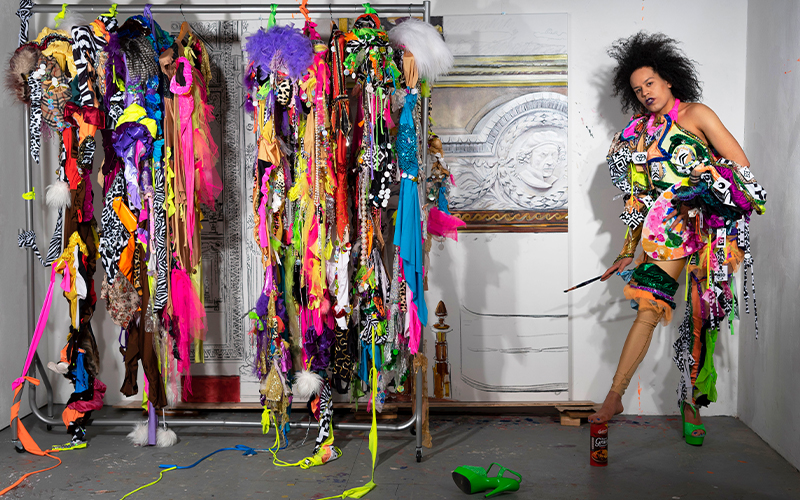Bedford is not a town you would usually associate with socially-engaged art — especially, a cultural museum revered for its rich historical collection of fine and decorative art and furniture. This museum, in particular, houses prints and works on paper by prominent modernist artists such as Pablo Picasso, Henry Moore, Bridget Riley, and Sonia Delaunay in its sphere. For multidisciplinary contemporary British artist and educator Quilla Constance (b.1980), also known as ‘QC,’ her latest self-curated solo project. Teasing Out Contingencies (2023), currently on view at The Higgins Bedford, has had a fascinating journey. In its infancy, the show faced a significant delay attributable to the pandemic before its debut—five years, to be precise.
What began as a series of innovative Open Studio performance workshops held for the now-defunct Tate Exchange at Tate Modern in (2019). Where over 1,000 diverse members of the public were invited to wear QC’s costumes, interact with various objects, and respond to an eclectic mashup of music genres while being photographed. Ultimately, led to QC’s latest survey of 8 large-scale oil paintings, placing a handful of willing workshop participants adorned in carnivalesque garb within Buckingham Palace’s decadent, palatial interior. In choosing the classical medium of oil painting, QC seamlessly combines traditional techniques with a modern, avant-garde vision. This radical choice underscores the evolving landscape of performance art, where time-honoured methods meet contemporary expression. This ambitious project was made possible thanks to the support of the Arts Council England, backing from Tate Exchange, The Higgins Bedford, Bedford Creative Arts (BCA), and Bedford Borough Council. Notably, the (BCA) played a crucial role in facilitating the workshops at Tate and has consistently supported the artist’s creative vision in her past and recent endeavours.
Additionally, visitors will witness a showy costume installation titled The Grenadiers (2023) adjacent to the artworks, some of which were worn by workshop participants at Tate Modern. The carnivalesque motifs in the exhibition transform the Sir William Harpur Gallery, where the works are presented, into an arena of playful rebellion. It captures the individuality and societal structures within a traditional museum setting, seamlessly integrating how the works are translated to museum-goers. Attendees will notice a distinct ambience in the space; canonical markers lend themselves to layered tropes and perceptions—triggered by familiarity or disconnect to the inscription ingrained in the works.
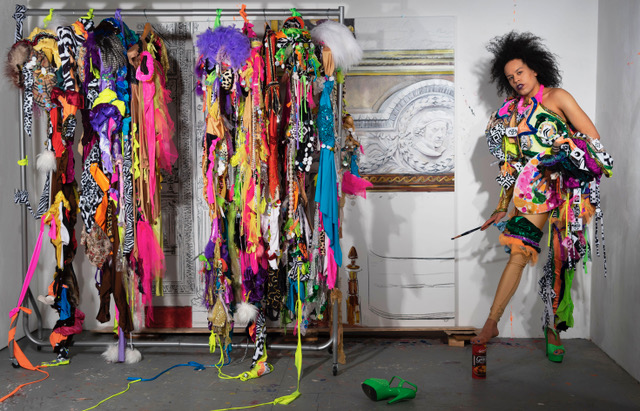
Drawing inspiration from twentieth-century European avant-garde art movements like Situationist International, Surrealists, and Dada—known for their anti-establishment stance—raises profound inquiries into the realms of our imagination and the world we perceive lore through multi-layered meanings.
QC tactically integrates facets of her artistic practice into the mainstream by embedding them within sociocultural contexts, concerning thorny matters such as social class, race, gender, subjectivity, ethnic identity, and the monarchy. The signifying aspects of her practice serve as a navigational journey through the complexities surrounding her mixed heritage. Often finding herself in spaces where traditional definitions of blackness can be limiting or exclusive. She grapples with the challenges of being perceived as “not Black enough” in spaces typically centred around Black entities while feeling somewhat out of place in those very spaces due to her lived experience as a mixed-race woman. Also, drawing from other personal experiences of being the only person of colour in predominantly white institutions. This delicate balancing act is akin to a tightrope walking between different cultures and identities. Passing until you don’t pass—being accepted until you’re not that constant fleeting in-betweenness. QC mentions “Rice and peas” and “Roast chicken with Paxo stuffing” in the same sentence when speaking about what Sunday dinners were like — growing up in Birmingham with a Jamaican father and English mother; this reference encapsulates the fusion of cultures and backgrounds reflecting the intricate interplay between the desire to authentically embrace all aspects of her identity without being impartial.
The theory of carnivalesque was formulated by Russian philosopher and literary linguist Mikhail Bakhtin, (1895 – 1975), who delved into the realms of playfulness and debauchery prevalent in medieval carnival festivities. He introduced the analogy of “crowning and uncrowning”, the carnival king and queen. Emphasising the possibility and process of individuals assuming the roles of king and queen rather than the actual crowning itself. QC shares a keen interest in the perpetual state of play and the exoticization found in all carnival traditions. She perceives these aspects as subversive and liberating, showcasing her intrigue in the multifaceted nature of carnival folklore.
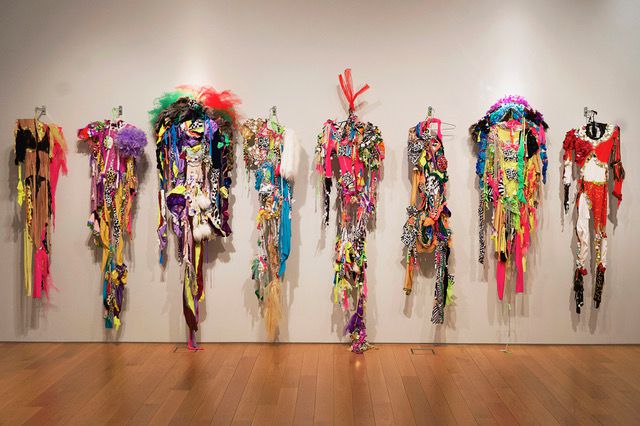
The Grenadiers (2023) costume installation is the most distinguishable reference to the artist’s documented unabashed performances. Audiences will also recognise the costumes from the workshop segment featured in the BAFTA-nominated TV series Rob & Romesh Vs. Art for Sky Max which garnered wider recognition during the lockdown when physical access to institutions like Tate was limited.
Perhaps the point of contention is the show’s mainstay: The British monarchy recognised as the preeminent authority in modern British society now under King Charles III’s sovereignty. QC works from actual photographic references taken from inside the palace. The painterly backdrops of her paintings provide illicit access into the outbound territory of Buckingham Palace. Which would usually be cordoned off to the general public.
Ownership is questioned when scrutinising how the Royal Family has acquired objects and to whom they attribute them to in terms of the copyright of intellectual property. On the flip side, one can argue that The Royal Collection Trust owns the copyright of the photographs, but who, originally, owned the acquired objects in the images? We cannot look at Europe’s colonial past through rose-coloured glasses and ignore post-colonial power structures at play here. Whether one identifies as a Royalist or not, many often assert their proximity to British culture. QC recounts an experience during her workshop where two distinct family groups interacted with her work. Upon their arrival, the Chinese family headed straight for the Bisto and Paxo, indicating a particular connection to these British culinary elements. On the other hand, a member of youth group who was of African descent chose to engage with the bone china, signifying their unique interaction with British culture. This diverse engagement reflects the multicultural tapestry that comprises modern British society. As shown in QC’s video Pukijam, (2015), using food is considered a signifier of a status symbol; in each of the paintings, the sitter is holding a pineapple in different ways.
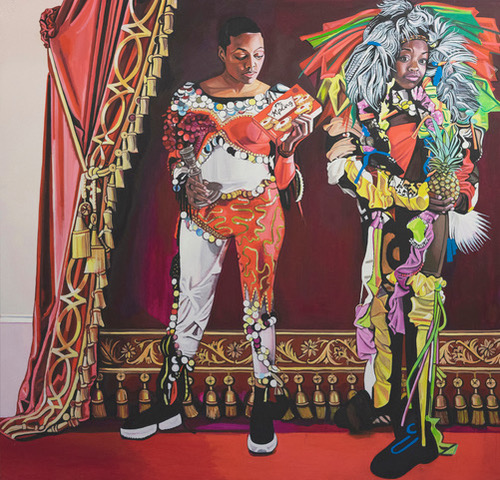
I was immediately drawn to Sista Signifier, (2023) because of its beguiling quality. We have seen Aindrea Emelife’s, concurrent BLACK VENUS (2023) presentation at Somerset House, London. A shift has highlighted the increasing visibility of stories and viewpoints related to Black femininity. This comes as a reaction to the past exclusion, inaccurate representation, and negative chronicles perpetuated in media, culture, and society.
The regal curtains of the palace backdrop are intentionally painted to match the sitters’ costumes. Kaleidoscopic detail envelopes the canvas; some may not pick up on the disconnect and connection between the two parties. Although they were photographed separately, QC cleverly paints them in situ as if they had been together the whole time. The viewer’s eye is inquisitively drawn to the woman looking at the well-known Mr. Kipling cake box and what appears to be a candle holder, in utter confusion.
The second sitter displays a bold and defiant expression, particularly while holding a pineapple. The facial expression is ambiguous, possibly conveying a sense of mockery or satire directed towards the exoticization often associated with objects like pineapples. Or objectifying individuals based on their cultural background. It symbolises a rebellion against reducing people to mere symbols or objects of fascination tied to their ethnicity or heritage.
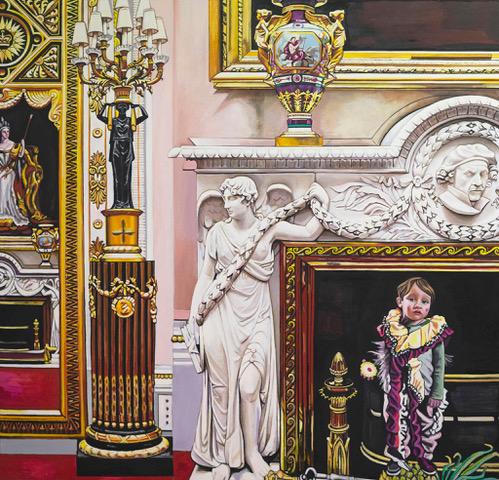
What we are witnessing in Fire Boy, (2023) is a re-imagining of innocence; the artwork’s composition provokes critical thought about preconceived notions and stereotypes. Associations with the white working-class Victorian chimney sweep era—the realisation that the child is standing before a fireplace amplifies this interpretation, connecting the visual elements with historical and societal contexts.
Fire Boy, (2023) is one of three works brimming with pictorial parallels that find their way into the project’s conceptual framework. QC’s deliberate choice to incorporate diverse art styles enables her to create unexpected but successful pairings within her work. The artwork exudes a notable classical ambiguity often reminiscent of settings like Versailles, adding an intriguing layer to the piece.
Moreover, the continued use of food as an object within the artwork conveys an ominous and metaphysical quality. The portrayal of food in this context teeters on the edge of distinction between trenchant expressive avenues, leaving the interpretation open-ended and inviting viewers to contemplate the more profound symbolism and meaning embedded in the piece.
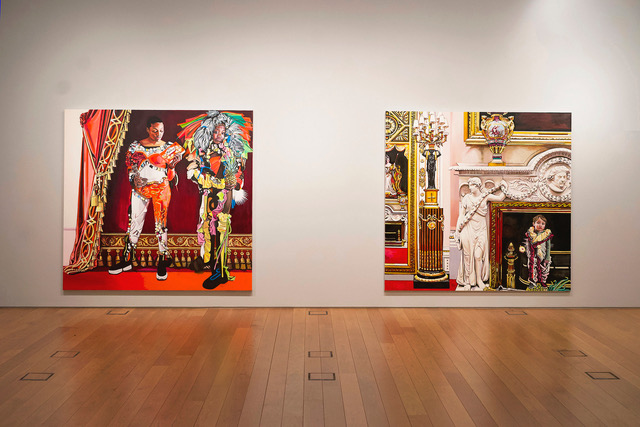
In the artwork titled Liminal Chinoiserie, (2023) an East-Asian woman is deliberately positioned theatrically. This woman hails from Japan, sparks inquiries into the Western tendency to oversimplify and homogenise various Asian cultures. The piece prompts contemplation on cultural labels and the perception of Asian countries, often unfairly deemed as underdeveloped. This juxtaposition draws parallels between branding and tribal marking, highlighting the accurate liminality that exists between playful comparisons. Notably, the vase remains intact, even though it appears as if it is about to tip over, defying expectations of its destruction.
A significant aspect of the piece raises concerns about cultural appropriation involving the replication of Chinese aesthetics by UK craftspeople who may not have the proper cultural understanding of the origin.
The discussion extends to the historical context of such mimicry, particularly in the 17th century, revealing the privileges associated with replicating artefacts from East-Asian cultural history. It is acknowledged that while this practice may be seen as a form of appreciation, it also has the potential to perpetuate cultural exploitation and marginalise the originators in the market. The artwork calls for a deeper examination of the complexities surrounding cultural representation and appropriation.
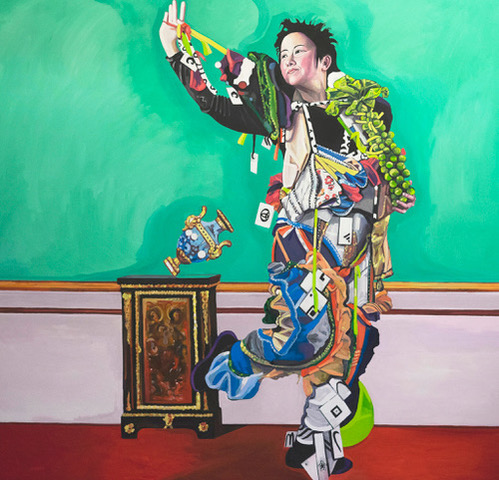
Under the’ QC’ moniker, Jennifer Allen has fashioned an ‘exotic’ militant punk persona built on the quintessence of an outsider, coming from the school of thought that “art should be accessible to everyone.” She often leans towards the underground and rebel subcultures that rally against prevailing power structures today.
Participants become active contributors to the artwork, blurring the lines between artist and subject and empowering them to be part of the creative process. In essence, QC’s decision to portray individuals in carnivalesque attire in the lavish setting of Buckingham Palace introduces a surreal quality that challenges perceptions of reality about the boundaries of imagination. The paintings take people to a different place in art, and viewers are encouraged to reassess and examine their preconceived perceptions. The collection of oil paintings stands as a testament to the transformative power of art, leaving a lasting imprint on all fortunate enough to experience its wonder. It serves as a conduit for visitors to connect with their histories and vulnerabilities. The show provides a fresh overview of QC’s continuing practice across painting as the path that enriches the work.
Quilla Constance, Teasing Out Contingencies, January 7th, 2024,The Higgins Bedford
